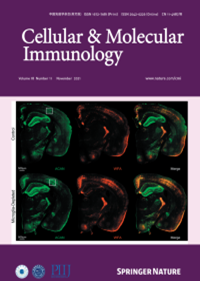角化细胞失调驱动系统性红斑狼疮发病。
IF 21.8
1区 医学
Q1 IMMUNOLOGY
引用次数: 0
摘要
系统性红斑狼疮(SLE)是一种复杂的多器官自身免疫性疾病。虽然人们普遍认为SLE起源于免疫细胞失调,但SLE的病因尚不清楚。在这里,我们提出了一个新的理论,其中SLE可以直接由角化细胞而不是免疫细胞的分子改变引发。我们发现过氧化物酶体增殖物激活受体γ (PPARγ)的水平在患者的皮肤病变中显著降低,并且在小鼠中复制这种降低导致疾病快速发作,具有SLE的多种特征。当角化细胞中的PPARγ减少,并伴随着干扰素调节因子3在I型干扰素位点的占用增加时,树突状细胞(dc)被招募到表皮,并被角化细胞分泌的I型干扰素激活。这些活化的dc迁移到局部引流淋巴结,在那里它们以非mhc ii依赖性的方式激活CD4+ T细胞,促进其分化为效应T细胞,从而导致疾病发作。我们的研究揭示了角化细胞的失调可能是SLE的致病驱动因素,并描述了一种模仿人类SLE的新小鼠模型。我们的数据还强调了皮肤免疫在全身性自身免疫性疾病发病中的关键作用。本文章由计算机程序翻译,如有差异,请以英文原文为准。

Dysregulation in keratinocytes drives systemic lupus erythematosus onset
Systemic lupus erythematosus (SLE) is a complex, multiorgan autoimmune disorder. Although it is widely believed that SLE originates from immune cell dysregulation, the etiology of SLE is not yet clear. Here, we propose a new theory in which SLE can be directly initiated by molecular alterations in keratinocytes rather than immune cells. We found that the level of peroxisome proliferator-activated receptor gamma (PPARγ) is substantially reduced in the skin lesions of patients, and replicating this reduction in mice led to rapid disease onset with multiple hallmarks of SLE. As PPARγ decreases in keratinocytes, which is accompanied by increased occupancy of interferon regulatory factor 3 at the type I interferon locus, dendritic cells (DCs) are recruited to the epidermis and are activated by keratinocyte-secreted type I interferon. These activated DCs migrate to local draining lymph nodes, where they activate CD4+ T cells in a non-MHC II-dependent manner, promoting their differentiation into effector T cells and thus contributing to disease onset. Our study revealed that the dysregulation of keratinocytes can be a pathogenic driver of SLE and describes a new mouse model that mimics human SLE. Our data also emphasize the pivotal role of skin immunity in the onset of systemic autoimmune disease.
求助全文
通过发布文献求助,成功后即可免费获取论文全文。
去求助
来源期刊
CiteScore
31.20
自引率
1.20%
发文量
903
审稿时长
1 months
期刊介绍:
Cellular & Molecular Immunology, a monthly journal from the Chinese Society of Immunology and the University of Science and Technology of China, serves as a comprehensive platform covering both basic immunology research and clinical applications. The journal publishes a variety of article types, including Articles, Review Articles, Mini Reviews, and Short Communications, focusing on diverse aspects of cellular and molecular immunology.

 求助内容:
求助内容: 应助结果提醒方式:
应助结果提醒方式:


